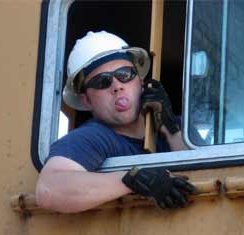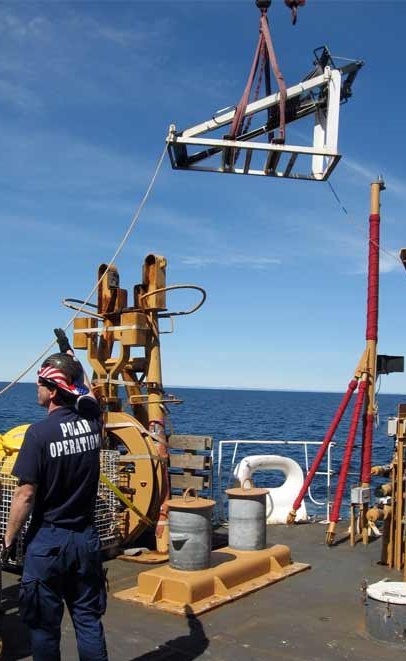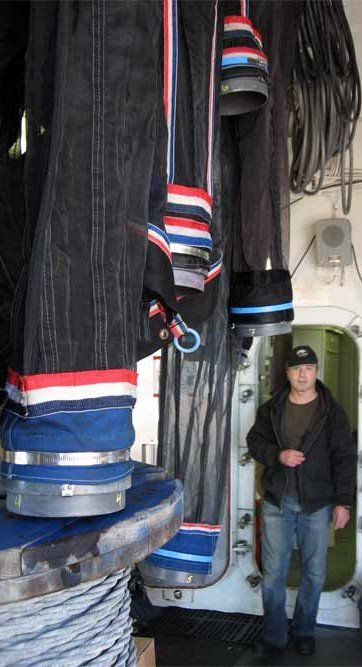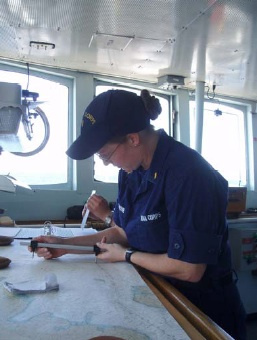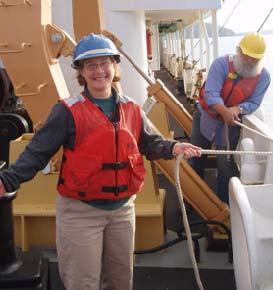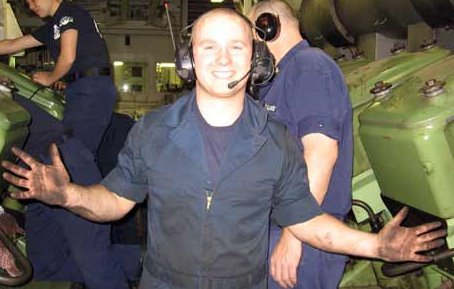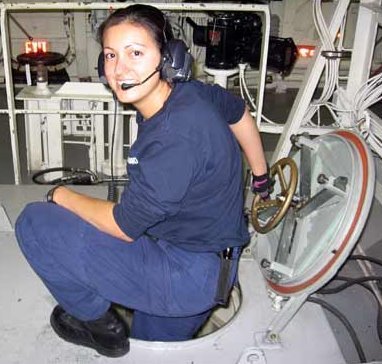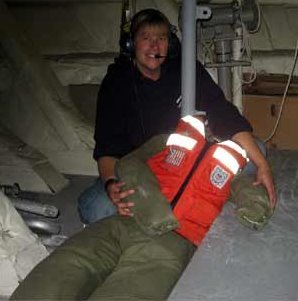NOAA Teacher at Sea
Lisbeth Uribe
Onboard NOAA Ship Delaware II
July 28 – August 8, 2008
Mission: Surfclam and quahog survey
Geographical Area: Southern New England and Georges Bank
Date: July 31, 2008
Ship Log
Man Overboard Drill
Just as the day watch started our shift we heard three short blasts of the ship’s horn, signaling a “Man Overboard” drill. While the crew was on deck (both on the bow (front of the ship) and stern (back), the Chief Boatswains Jon Forgione and Leno Luis put on life vests and safety helmets and were lowered into the water in a rigid haul inflatable boat (RHIB). When those on board the ship sighted the dummy victim, we raised our arms and pointed in its direction. The rescuers then headed in the direction the crew were pointing. At the same time, the Operations Officer and Medical Person in Charge (MPIC) Claire Surrey readied her gear to perform life saving measures once the victim was safely brought on the deck. Rescue protocols are taken very seriously as they are designed to keep all members of the crew safe. Once the MPIC determined the dummy victim was breathing on their own and required no further medical assistance, the drill was over and the crew returned to their stations or berths (sleeping rooms).
Scuba Divers to the Rescue!
Not long after the man overboard drill, the dredge rolled when it was being hauled from the sea floor, wrapping the hawser (floating tow line) underneath the cage. To make matters worse, as the dredge was being lifted up the ramp on deck, the hawser became caught in the ship’s rudder. Our three NOAA Working Divers, Executive Officer (XO) Monty Spencer, Chief Steward (chef), MPIC Jonathan Rockwell and MPIC Claire Surrey suited up in scuba suits for a dive to untangle the rudder. NOAA Working Divers must complete a 3-week training course. They are skilled at ship husbandry, such as working on the rudder, propellers, zincs (metal zinc objects that are placed on the hull of a ship to attract corrosion), and the bow thruster (a tunnel through the ship with a propeller to help direct the bow when docking).

Chief Steward Jonathan Rockwell preparing to dive below the ship to untangle the hawser line from the rudder.
The diver breathes air through a mouthpiece, called a regulator, from a scuba tank of compressed air that is strapped to the diver’s back. The regulator, connected by a hose to the tank, adjusts the air in the tank to the correct pressure that a diver can safely breathe at any given depth. Originally called the “aqua-lung”, “scuba” stands for self-contained underwater breathing apparatus. Scuba gear has helped scientists explore the ocean, however, the equipment does have limitations. The deepest dive that can be made by a NOAA scuba diver is about 40 meters, but the average depth of the ocean is about 3,800 meters. The increased water pressure of the dive limits the depth of the descent of a scuba diver.
As Monty and Jonathan plunged into the ocean, the rigid haul inflatable boat (RHIB) was deployed with General Vessel Assistant (GVA) Adam Fishbein and Chief Boatswains, Jon Forgione at the tiller arm, to assist in diver rescue operations if needed. On standby in full scuba gear was MPIC Claire Surrey in case the divers ran into any trouble. In no time at all the divers freed the tangled hawser from the rudder and were back on board. At each step of the job, great care was taken to check all gear and ensure the safety of the crew.
Question: What is the depth and name of the deepest part of the ocean?
Science and Technology Log
As I mentioned in my first log, we are targeting two species of clams during our survey, the Atlantic Surf clams (Spissula solidissima) and Ocean Quahogs (Arctica islandica). They are very easy to tell apart, as the surf clam is much larger (about 18 cm in width) and lighter in color. “Quahog” (pronounced “koh-hawg”) originated from the Narrangansett tribe that lived in Rhode Island and portions of Connecticut and Massachusetts. Atlantic surf clams are a productive species, in that they are faster growing, with a lifespan of about 15 years, with variable recruitment (reproductive cycles). They are much smaller and typically found in more shallow waters (<50 meters) from Cape Hatteras to Newfoundland than the ocean quahog. The Quahog lives in depths of 50-100 meters in US waters (from Cape Hatteras up to the north Atlantic (Iceland), and also in the Mediterranean). Quahogs grow slowly, and typically live for more than 100 years, with infrequent and regional recruitment.
There is a great variety of material, both organic and inorganic that is collected by the dredge providing a snapshot of the habitat below. At times it is sandy, sometimes the sediment is the consistency of thick clay, in which case we must re-submerge the dredge for a few minutes to clean the cage. At other times large rocks and boulders are captured.

Live clams, shells and other material collected in the dredge. All the material is sorted, weighed and measured as part of the survey.
Atlantic Surf Clams and Ocean Quahogs live in a part of the ocean called the subtidal zone. Their habitat is the sandy, muddy area that is affected by underwater turbulence but beyond heavy wave impact. In addition to clams, our dredge is capturing a variety of organisms perfectly adapted to this environment, such as sponges, marine snails and sea stars that are able to cling to hard materials to protect them from being swept away by ocean currents and waves. Marine snails and hermit crabs are also able to cling to surfaces. Like the clam, many organisms have flattened bodies, thereby reducing their exposure to the pull of waves and currents. We find flat fish, such as flounder and skate, which avoid turbulence and their enemies by burying themselves in the sand. Flounder prey on sand dollars, another flat organism living in the subtidal zone. In many hauls of the dredge, the cage is filled with sand dollars. We have collected lots of other interesting animals, such as hermit crabs, worms, sea jellies, sea mice and, less often, crabs and sea urchins. The Sea Mouse is plump, about 10 cm in length, segmented and covered in a large number of grey brown bristles that give it a furry appearance.
Question: What is the longest-lived animal on record?
Personal Log
The main difficulty I have with writing this log is choosing what to cover. Each day is filled with new and interesting experiences. I am learning so much, not only about the science behind the clam survey, but also about the ship itself and the skills necessary to operate the ship and conduct a marine survey. Everyone has been extremely generous with sharing his or her knowledge and experience with me. While cleaning the inside of the dredge last night one of the wires made a small tear in the seat of my waterproof overalls. Now I know to pack a bike inner tube repair kit if I am lucky enough to be invited to join another survey cruise! One of those small rubber patches would have been the perfect for the job. I was able to find a sewing kit and in short order sewed the tear and sealed it with a layer of duct tape. Now I am ready to get back to work!













